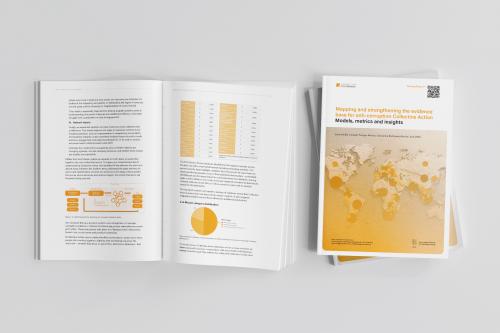Wildlife trafficking in Uganda: poverty, governance and perceptions

Our recent policy brief on Curbing wildlife trafficking in Uganda: lessons for practitioners summarises the main findings from extensive field research on the drivers, facilitators and strategies of wildlife trafficking in Uganda.
Applying a behavioural lens, the first research question looks at why Uganda has become a hub for wildlife trafficking in East Africa. Our field research covered 47 interviews and six focus group discussions with reformed poachers and members of communities located near wildlife habitats. Here are the findings to that first question. For the full details and academic references, please see the PDF.
So why does wildlife trafficking happen in Uganda? The research evidence suggests there are three key drivers and facilitators:
1. Wildlife trafficking is a way to meet economic needs
The wildlife trafficking supply chain starts in and around rural areas near natural habitats from where wildlife goods are transported to larger towns. These areas are often afflicted by high levels of poverty and unmet needs, which means that money-making opportunities are not easily passed up, even if they are illicit.
This is most vividly illustrated when focus group participants discuss an offer that the fictional “Daniel” receives to help in the transport of wildlife products:
Daniel has a job as a daily labourer. He is a father and together with his wife, he raises his 5- and 2-year-old daughters. One day Daniel is approached by an old acquaintance named Peter. Peter asks him if he would be interested in helping his business. Peter moves wildlife goods, such as ivory and horn, from one city to another in Uganda. Peter could really use Daniel’s help with different tasks, such as: packaging the wildlife goods in different boxes; stacking and organising these boxes in a local warehouse; and loading these boxes onto trucks ready for transport to other cities. The prospect of earning a substantial higher income than he has now has him interested. But he is not sure.
Research participants note that most individuals (irrespective of gender) who might find themselves in the position of “Daniel” would surely take the offer. Because livelihood opportunities are constrained, accepting a lucrative business deal that can support both “Daniel” and his family is viewed as an appropriate decision.
Adding to this, the evidence from the research suggests that social pressures compound the incentives against rejecting such an offer, even if it is known that the activities are illegal and there might be a risk of getting caught, because doing so would be considered foolish in the eyes of family and friends.
2. Wildlife trafficking is facilitated by weak governance
Uganda has a comprehensive framework in place to prevent and curb wildlife trafficking, including a new Wildlife Act in 2019. Additionally, a specialised Standards, Wildlife and Utilities Court has been set up to deal with cases of wildlife crime (a first in the continent) and a large intergovernmental committee has been tasked to co-ordinate anti-poaching activities and curb wildlife trafficking across the country.
But laws, regulations and taskforces have limited impact when there is a sizeable implementation gap, as is the case in many sectors and agencies in Uganda. In turn, high levels of informality characterise many public sector institutions in Uganda, including some of those tasked with enforcing sanctions for inappropriate behaviour of public officials.
Informality refers to the presence of powerful yet unofficial systems of governance within the public sphere. Indeed, the prevalence of informal ways of operating (through unwritten norms, understandings and even accountability relationships) is associated with high levels of corruption in many countries, including Uganda.
This provides the background to understand why trafficking networks are able to instrumentally co-opt individuals in positions of public authority, building and nourishing informal relationships with officials who can help turn a blind eye to certain shipments, or who might help with the release of a detained trafficker.
3. Stereotypes about wildlife trafficking
People often make sense of their environment and justify their decisions based on commonly held narratives, views, or stereotypes also known as mental models. For example, mental models provide shortcuts to judge whether an action is pertinent and acceptable under certain circumstances. Mental models also shape the expectations about behaviours associated with certain roles (e.g. “all politicians are corrupt).
Stereotypes and casual narratives are always at play and at a very basic level help with making decisions, i.e. to accept or decline a lucrative yet illegal offer to support trafficking and the justifications for it. Therefore, understanding and framing the meanings ascribed to wildlife and wildlife trafficking within their broader context is important.
In this regard, it is noteworthy that many anti-poaching and trafficking campaigns often invoke the notion that it is important to care for wild animals. But the research evidence suggests that this association is perhaps too distant from the way in which wild animals and trafficking are viewed by those on the ground.
Rather, the research suggests that wildlife is frequently characterised as not ecologically valuable. Frequent stereotypes involve wildlife being seen as commodities to be used, as resources that are owned by the state (and therefore belong to nobody), or competing with humans over already stressed natural and public resources.
Wildlife trafficking also lacks the negative connotation that those unfamiliar with the context may automatically assume it to have. Wildlife products are viewed very positively, as valuable, rare and as symbols of status and power. Trafficking, in turn, is viewed as a benign form of informal trade that is legitimate, whether legal or not, and a source of wealth and status.
The perspectives of focus group participants regarding the fictitious business man “Peter” who offers “Daniel” a business opportunity by transporting wildlife products are indicative. He was not characterised as a criminal but as a wealthy and generous individual who provides opportunities for the needy.
Utilitarian perspectives of wildlife, alongside characterisations of wildlife trafficking as a benign, legitimate form of informal trade that brings wealth and status, fuels the social acceptability of wildlife trafficking. Such sentiments can provide the justification needed to accept opportunities to support illegal activities. These range from citizens who transport products across the border to public officials who look away for a small fee.
Takeaway
In brief, the research shows that individuals engaging in the initial stages of wildlife trafficking chain are driven predominantly by aspirations of wealth to overcome socio-economic hardships. This is reinforced by a context in which informal relationships prevail over formal governance structures and by stereotypes that depict trading in wildlife products as benign and legitimate.
Learn more
- Download the full policy brief here.
- Read Working Paper 33: A worm’s-eye view of wildlife trafficking in Uganda – the path of least resistance.
- Find out more about our Public Governance team and their current research projects.
- Learn more about the Basel Institute's Green Corruption programme, including our two-year PMI Impact-funded project to prevent corruption from fuelling illegal wildlife trade along the East Africa - South East Asia route. We are grateful to PMI Impact for funding this valuable research.




